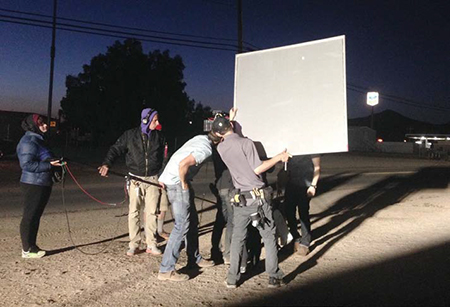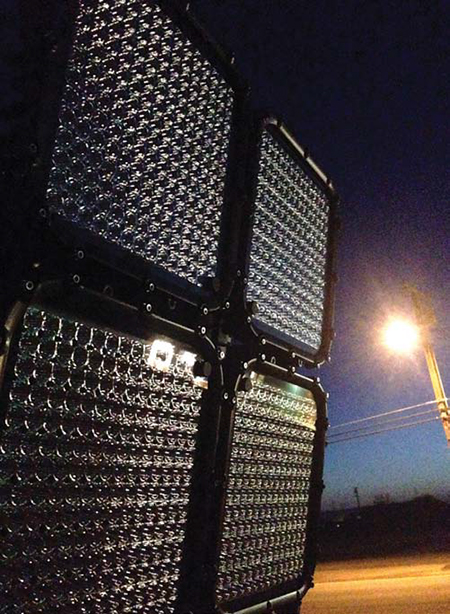LEDs: An Update on Studio Lighting
I was asked to give a short talk at this year’s NAB Show on new technology for studio lighting. The talk was on the very first day of the conference as part of the Broadcast Engineering Conference panels. I teased the audience first by noting that they were probably all expecting me to discuss LED technology, but, instead, I was going to discuss Nobel Peace Prize winners. I wasn’t kidding!
Shuji Nakamura, Isamu Akasaki and Hiroshi Amano were the three winners of the Nobel Peace Prize for Physics in 2014. Their work, completed in the early 1990s, was the foundation for my whole talk and for the most exciting technology in studio lighting!

On the set of the film “Of Fortune and Gold” (now in post production), Gaffer Jacob Abrams handholds a 4x4 frame of light gridcloth to diffuse the intense light coming from the 12K Cinemills LED fixture. Of course, their prize was awarded for the invention of the blue LED. Yes, just as everyone expected, LEDs were the topic of my talk. After the Blue LED came into being, LEDs suddenly graduated from the thankless and oft-dismissed world of indicator lights into a whole new world as a legitimate luminary. Although our first years with LEDs were filled with 1x1 panels and small onboard lighting fixtures, the past couple of years have seen a rise in legitimate studio lighting fixtures.
ADVANTAGES OF THE LED
The LED, of course, has many advantages over traditional incandescent sources: they generate almost no heat, are nearly 20 times more efficient in their usage of wattage per lumen output, last substantially longer, are easily dimmed without color change and can be clustered together for alteration of color output from a single fixture.
None of this is really news, however. The news comes from recent advancements in LED fixtures: more Fresnels, Space Lights, larger flat-panel soft sources and a 12K LED that blew my mind.

The Cinemills 12K fixture on a CrankOVator stand being powered by a power inverter inside the passenger van.

Beating daylight. The 12K Cinemills LED working during the late afternoon to provide hot sunlight through the window of the picture vehicle on the set of “Of Fortune and Gold.” Some of the earliest in the Fresnel category were Litepanels’ with their Inca and Sola fixtures. They were very large—about the size of a baby 10K—but they created some very beautiful light quality. Mole-Richardson came on the scene with LED conversion kits for their existing fixtures. Do you have an arsenal of Babys or Juniors? Convert them to LED. Now Mole offers LED Fresnels to compliment nearly their full line of incandescent fixtures: Tweenies, Babys, Juniors and even a Senior! Yes, a 5K LED Fresnel that only uses 900 Watts of power. That’s the equivalent lumen output of a 5K tungsten that you can plug into a standard wall outlet and it comes in tungsten or daylight color balance. All of the Mole fixtures are dimmable and DMX addressable.
The professional video industry's #1 source for news, trends and product and tech information. Sign up below.
Arri offers several high-end LED Fresnel options: the L-5, L-7 and brand new L-10. All of the fixtures are available in “C” (color changing), D (daylight color balance) or T (tungsten color balance). Just like Mole, all of their fixtures are dimmable and DMX addressable.
On the subject of DMX, that’s another extraordinary benefit to LED fixtures—the dimmers are built in to the fixtures eliminating the need for dimmer room or dimmer packs at all! If you’ve got an existing facility, the dimmer packs will make nice eBay sales for people looking for cool paperweights! For a new facility, this is a significant cost and space savings.
Fiilex introduced a new Q1000 Fresnel, a bi-color fixture with color variation from 2,800K to 6,500K and CRIs of 96–98 along with built-in green/magenta shift control. The fixture looks compact and well-designed.
Lupolux offers two LED Fresnel options in either daylight or tungsten color balance: a 650-Watt equivalent (50-Watt consumption) and a 1,000- Watt equivalent (90-Watt consumption), the larger fixture with an impressive 9-inch diameter lens.
Moving away from Fresnel fixtures, Cinemills has their Cinesoft fixtures in 50W, 100W and 200W options—each getting progressively physically larger to offer even softer sources. They’re a flat panel with a thick milked front to eliminate the individual harsh lamps from many LEDs. KinoFlo has had their Celeb fixture for some time, also a very soft and compact fixture with color change between tungsten and daylight.
Getting larger, Fill-Lite offers the Studio fixture, a 51 x 59-inch soft source with color change that can easily replace a large softbox in a significantly smaller footprint. It separates into two pieces for easier storage and transporting.
Very little heats up a stage faster than a large collection of 5K or 6K tungsten spacelights. Although they provide wonderfully soft and natural top light, they require heavy cabling and generate a great deal of heat. LED spacelights from Mole-Richardson, Olesen and Nila, among others, offer a fantastic nearly heatless alternative that simplifies cabling, are controlled via DMX and available in daylight or tungsten.

The face of the Cinemills 12K LED with the circular reflectors clearly seen in the 4 1x1 panels.ON THE SET
Perhaps the most outstanding fixture I’ve seen recently is Cinemills new 12K LED. That’s right—a 12K LED fixture. It looks like four 1x1 fixtures linked together in a single fixture. Each individual daylight LED features a highly efficient reflector that allows the fixture to pack a significant wallop.
I was producing additional photography for an independent feature called “Of Fortune and Gold,” written and directed by Jared Marshall. The cinematographer on the film was my former Global Cinematography Institute student, Idan Menin. His gaffer, Jacob Abrams, had arranged with Cinemills to be a test project for their prototype fixture. I was excited to check out this new toy, but was a little underwhelmed when they pulled it off the truck. Just another collection of 1x1 panels?
My initial thoughts were immediately rebuked when we fired up the fixture. From about 300 yards away it lit up the width of a city block. From an LED fixture! Even crazier, we were powering it off of a DC inverter connected to the battery of our passenger van. The light gave us the output and quality of roughly a nine-light Maxibrute. Although I didn’t have a chance to do any thorough tests or take any photometrics, the overall performance was truly stunning and “led” me to realize that LEDs had truly come of age as a legitimate—and formidable—production lighting tool.
Jay Holben is the author of the book “A Shot in the Dark: A Creative DIY Guide to Digital Video Lighting on (Almost) No Budget.”
